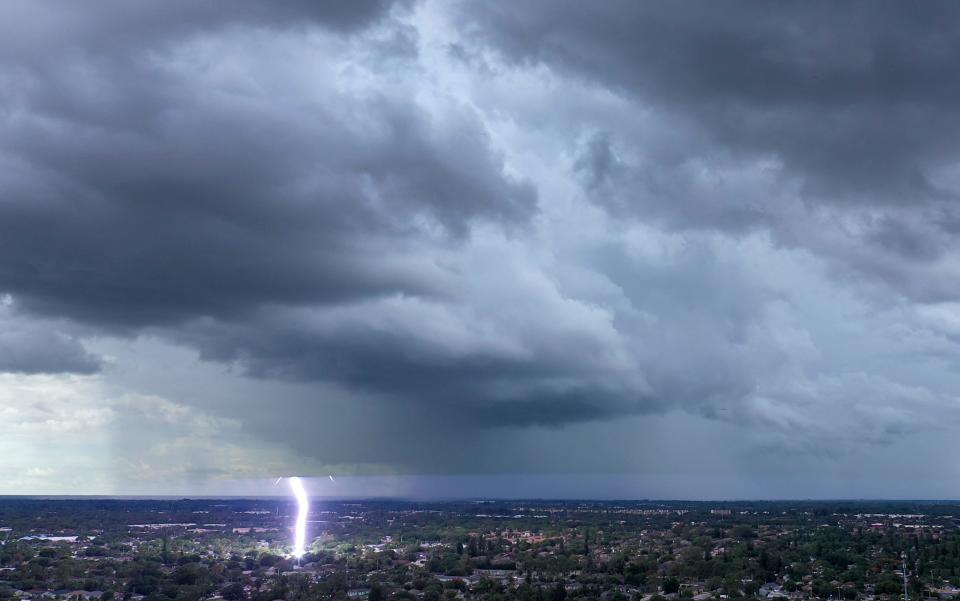There's more lightning strikes now. Here's how to stay safe during severe thunderstorms
A New Jersey man, warning others of an approaching storm, was found dead Sunday, killed by a lightning strike.
In Illinois, lightning traveled through a tree and the ground to strike another man on Tuesday, putting him in the hospital, according to NBC Chicago.
Also on Tuesday in Wisconsin, there were four reported lightning strikes -- two that damaged houses, one that burned a barn to the ground and another that sparked a transformer fire, writes a CBS affiliate in Green Bay.
Lightning strikes, and the damage they cause, are on the rise, USA TODAY is reporting. This week -- June 23-29 -- is Lightning Awareness Week, and the National Weather Service has advice on how to protect yourself and your property.
Lightning strikes growing in the United States
Vaisala Xweather, which tracks lightning, is tallied just over 242 million bolts of lightning in the U.S. in 2023. The company tells USA TODAY that the total is the most in at least the past seven years.
Where does Ohio rank for lightning strikes?
Ohio ranks No. 22 on Vaisala Xweather's list for total lightning count, at 2,865,371 flashes, behind Indiana but ahead of North Dakota. Texas is far and away the No. 1 state for lightning strikes, with over 42 million counted. That's more than double No. 2 Florida, at 19 million.
Ohio has averaged 460,074 cloud-to-ground lightning strikes per year from 1997 through 2012, according to the National Weather Service. The Buckeye State is tied for 12th place with Kentucky for the average number of lightning fatalities per year (10) from 2001 to 2013.
How to staying safe when lightning flashes, per the National Weather Service
According to the NWS, there are about 25 million close-to-ground lightning strikes each year in the United States, which cause an average of 51 fatalities. However, only about 10% of people struck by lightning are killed. The rest have varying degrees of discomfort and disability, sometimes for the rest of their lives.
Here's what you need to know about lightning safety, according to the NWS:
No place outdoors is safe when thunderstorms are in the area.
If you can hear thunder, lightning is close enough to strike you.
When you hear thunder, immediately move to safe shelter: a substantial building with electricity or plumbing or an enclosed, metal-topped vehicle with windows up.
Stay sheltered at least 30 minutes after you hear the last sound of thunder.
If you're indoors, stay safe from lightning by:
Staying off corded phones, computers and other electrical equipment that put you in direct contact with electricity.
Avoiding plumbing, including sinks, baths and faucets.
Staying away from windows and doors, and stay off porches.
Not lying on concrete floors, nor leaning against concrete walls.
If you are caught outside with no safe shelter, the NWS suggests the following as a last resort:
Immediately get off elevated areas such as hills, mountain ridges or peaks
Never lie flat on the ground
Never shelter under an isolated tree
Never use a cliff or rocky overhang for shelter
Immediately get out and away from ponds, lakes and other bodies of water
Stay away from objects that conduct electricity (barbed wire fences, power lines, windmills, etc.)

Can cars get struck by lightning?
Yes, cars can get struck by lightning. However, if you are inside a car with a metal roof, you're usually protected from a lightning strike, according to the NWS. Typically, lightning will strike the antenna or the roofline, then pass through the outer metal shell and through the tires into the ground.
Just leaning on the outside of the car will not protect you, the NWS says.
Can lightning strike twice in the same place?
It's a myth that lightning never strikes the same place twice, according to the National Oceanic and Atmospheric Administration. It can and it does, especially if it's a tall, isolated object. The NOAA cites the Empire State Building as an example, which is struck by lightning about 25 times each year.
How many volts are in a lightning strike?
A typical lightning bolt carries about 300 million volts and 30,000 amps, according to the NWS. Compare that to the typical household's electric current, which supplies 120 volts and 15 amps.
This article originally appeared on Record-Courier: Don't get struck by lightning—how to stay safe in severe weather

